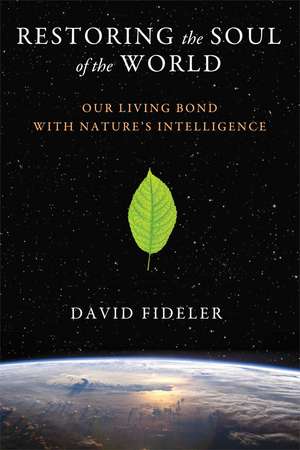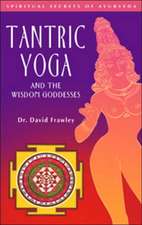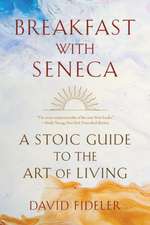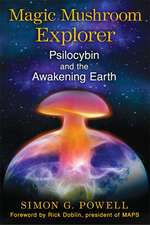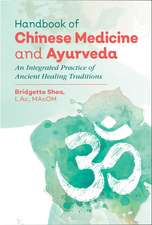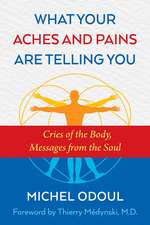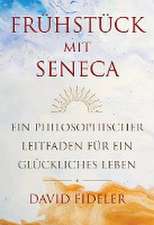Restoring the Soul of the World: Our Living Bond with Nature's Intelligence
Autor David Fideleren Limba Engleză Paperback – 18 dec 2014
Drawing upon the most important scientific discoveries of recent times, David Fideler explores the self-organizing intelligence at the heart of nature and humanity's place in the cosmic pattern. He examines the ancient vision of the living cosmos from its roots in the "world soul" of the Greeks and the alchemical tradition, to its eclipse during the Scientific Revolution, to its return today. He explains how the mechanistic worldview led to humanity's profound sense of alienation, for if the universe only functioned as a machine, there was no longer any room for genuine creativity or spontaneity. He shows how this isn't the case and how, even at the molecular level, natural systems engage in self-organization, self-preservation, and creative problem-solving, mirroring the ancient idea of a creative intelligence that exists deep within the heart of nature.
Revealing new connections between science, religion, and culture, Fideler explores how to reengage our creative partnership with nature and new ways to collaborate with nature's intelligence.
Preț: 79.77 lei
Preț vechi: 111.55 lei
-28% Nou
Puncte Express: 120
Preț estimativ în valută:
15.27€ • 15.88$ • 12.60£
15.27€ • 15.88$ • 12.60£
Carte disponibilă
Livrare economică 28 martie-09 aprilie
Preluare comenzi: 021 569.72.76
Specificații
ISBN-13: 9781620553596
ISBN-10: 1620553597
Pagini: 320
Ilustrații: 30 b&w illustrations
Dimensiuni: 152 x 229 x 18 mm
Greutate: 0.5 kg
Editura: Inner Traditions/Bear & Company
Colecția Inner Traditions
ISBN-10: 1620553597
Pagini: 320
Ilustrații: 30 b&w illustrations
Dimensiuni: 152 x 229 x 18 mm
Greutate: 0.5 kg
Editura: Inner Traditions/Bear & Company
Colecția Inner Traditions
Notă biografică
David Fideler holds a Ph.D. in philosophy and the history of science and cosmology. A recognized authority on the Pythagorean school, he is the editor of The Pythagorean Sourcebook and Library; author of Jesus Christ, Sun of God; translator of Love’s Alchemy; and editor of the humanities journal Alexandria.
Extras
Chapter 10
The Mirror of Nature
Modern Cosmology and the Reanimation of the Universe
You may drive out Nature with a pitchfork, but she will always come back.
--Horace
Lost in Starlight
It’s a dark, moonless night in early June. To escape the light pollution of my native town, at least once a year I make the pilgrimage north to the pristine, dark skies of Sleeping Bear Dunes National Lakeshore on the shores of Lake Michigan. There I rent a cottage at the Shady Shores Resort on the bank of Little Glen Lake and spend the days walking exquisite trails that lead to overlooks hovering hundreds of feet above Lake Michigan. At night I pack up my telescope and head out to a favorite observing site.
Twilight has past and darkness has fallen. Silhouettes of pine trees hug the horizon, illuminated by starlight. They punctuate the skyline and bridge the Earth to sky, a comforting reminder of where I stand on the face of our living planet. The night itself is deep and laced with mystery, extending off into the trees and countryside, and extending out endlessly into the infinite depths above. It’s early in the season so my activity is greeted by the song of some crickets, but not by the full-blown insect chorus of the late summer.
In the sea of darkness I seem isolated and exposed; a shuffle of activity making final preparations under the glow of a red flashlight. The telescope itself is large, extremely heavy, and rock solid. Having mounted it firmly on the tripod, I’m making the final electrical connections. The telescope is motorized and has a 64,000 object database. Now that it’s plugged into my car’s electrical system, I need only type a few keystrokes into the hand-controller and the telescope will slew across the sky, center any selected object in the field of view, and emit a beep--a wordless indication that observing can begin.
Before pressing any buttons, I look up and around, amazed by the vista. . . . Heaven and Earth are bound together by one luminous glow, the combined illumination of millions and millions of stars in our home galaxy. As I trace the textures and curtains of the vibrant tapestry through binoculars, the boundaries of daylight consciousness dissolve. My soul, my mind, and even my body are adrift, embraced and engulfed by the pulsating star stream. Like the words of the poet Kenneth Rexroth:
The stars stand around me
Like gold eyes. I can no longer
Tell where I begin and leave off.
At this time of year it’s impossible not to explore the rich starfields by the constellation Sagittarius. Shaped like a giant teapot, Sagittarius is climbing higher in the south. From the spout of the teapot emerges the hot, white steam of the Milky Way, a particularly brilliant and shining starcloud. . . . Right off the tip of the giant teapot is the heart of our own Milky Way Galaxy, some 25,000 light-years away. Encircling this core are the billions of stars that make up our galaxy and through a medium-size telescope you can see endless wonders. The region is rich in star clusters and contains the awesome Trifid and Lagoon nebulae, glowing clouds where new stars are coming to birth. But just as striking are the dozen or so globular clusters that you can see orbiting the central hub of our galaxy. The globular clusters are tightly packed spheres of ancient suns, each one containing between 500,000 and a million stars. Through a telescope they are a stunning sight, like countless diamonds huddled together in a sparkling, shivering orb.
Like the Roman god Janus, technology has two faces. On the one hand, technology separates and insulates us from the world. Because of the effects of technology, I am no longer able to experience the deep beauty of the sky and the Milky Way in my hometown. On the other hand, thanks to technology I am able to gaze into the deepest heart of our galaxy from my northern hideaway and actually understand what I’m looking at. Science and the development of technology go hand in hand, and the ever-increasing precision of technology has allowed us to gaze ever deeper into the microworld of the atom and the macroworld of the greater universe. And in the process, our observations and insights have increasingly eroded the premises of the mechanistic worldview. In fact, modern physics has proved that every major assumption of Newtonian science was flawed or incorrect.
It is no exaggeration to say that we are living in the wake of a cosmological revolution, for the most astonishing scientific discoveries of all time have been made only over the past one hundred years. These discoveries, made in astronomy and physics, have completely changed our understanding of the nature of matter and humanity’s place in the seemingly infinite cosmic tapestry. While this revolution is far from over, as philosopher E. A. Burtt pointed out, a cosmology or world picture is a civilization’s most vital possession, for our worldviews affect the way that we understand our relationship to the world and other people. As he wrote, “In the last analysis, it is the ultimate picture which an age forms of the nature of its world that is its most fundamental possession. It is the final controlling factor in all thinking whatever.” If the mechanistic world-view had implied that matter was dead and humanity was essentially distinct from nature, that viewpoint had inevitable social and ecological consequences. Now under the spell of the new discoveries, matter itself has returned to life. Nature can no longer be seen as a static, unchanging machine, and we now understand that all living beings are deeply interconnected, having emerged from the unfolding tapestry of the evolutionary universe. By necessity, as this vision becomes more deeply assimilated by society, it will affect the way that we envision human nature and relate to the world in the twenty-first century.
The Mirror of Nature
Modern Cosmology and the Reanimation of the Universe
You may drive out Nature with a pitchfork, but she will always come back.
--Horace
Lost in Starlight
It’s a dark, moonless night in early June. To escape the light pollution of my native town, at least once a year I make the pilgrimage north to the pristine, dark skies of Sleeping Bear Dunes National Lakeshore on the shores of Lake Michigan. There I rent a cottage at the Shady Shores Resort on the bank of Little Glen Lake and spend the days walking exquisite trails that lead to overlooks hovering hundreds of feet above Lake Michigan. At night I pack up my telescope and head out to a favorite observing site.
Twilight has past and darkness has fallen. Silhouettes of pine trees hug the horizon, illuminated by starlight. They punctuate the skyline and bridge the Earth to sky, a comforting reminder of where I stand on the face of our living planet. The night itself is deep and laced with mystery, extending off into the trees and countryside, and extending out endlessly into the infinite depths above. It’s early in the season so my activity is greeted by the song of some crickets, but not by the full-blown insect chorus of the late summer.
In the sea of darkness I seem isolated and exposed; a shuffle of activity making final preparations under the glow of a red flashlight. The telescope itself is large, extremely heavy, and rock solid. Having mounted it firmly on the tripod, I’m making the final electrical connections. The telescope is motorized and has a 64,000 object database. Now that it’s plugged into my car’s electrical system, I need only type a few keystrokes into the hand-controller and the telescope will slew across the sky, center any selected object in the field of view, and emit a beep--a wordless indication that observing can begin.
Before pressing any buttons, I look up and around, amazed by the vista. . . . Heaven and Earth are bound together by one luminous glow, the combined illumination of millions and millions of stars in our home galaxy. As I trace the textures and curtains of the vibrant tapestry through binoculars, the boundaries of daylight consciousness dissolve. My soul, my mind, and even my body are adrift, embraced and engulfed by the pulsating star stream. Like the words of the poet Kenneth Rexroth:
The stars stand around me
Like gold eyes. I can no longer
Tell where I begin and leave off.
At this time of year it’s impossible not to explore the rich starfields by the constellation Sagittarius. Shaped like a giant teapot, Sagittarius is climbing higher in the south. From the spout of the teapot emerges the hot, white steam of the Milky Way, a particularly brilliant and shining starcloud. . . . Right off the tip of the giant teapot is the heart of our own Milky Way Galaxy, some 25,000 light-years away. Encircling this core are the billions of stars that make up our galaxy and through a medium-size telescope you can see endless wonders. The region is rich in star clusters and contains the awesome Trifid and Lagoon nebulae, glowing clouds where new stars are coming to birth. But just as striking are the dozen or so globular clusters that you can see orbiting the central hub of our galaxy. The globular clusters are tightly packed spheres of ancient suns, each one containing between 500,000 and a million stars. Through a telescope they are a stunning sight, like countless diamonds huddled together in a sparkling, shivering orb.
Like the Roman god Janus, technology has two faces. On the one hand, technology separates and insulates us from the world. Because of the effects of technology, I am no longer able to experience the deep beauty of the sky and the Milky Way in my hometown. On the other hand, thanks to technology I am able to gaze into the deepest heart of our galaxy from my northern hideaway and actually understand what I’m looking at. Science and the development of technology go hand in hand, and the ever-increasing precision of technology has allowed us to gaze ever deeper into the microworld of the atom and the macroworld of the greater universe. And in the process, our observations and insights have increasingly eroded the premises of the mechanistic worldview. In fact, modern physics has proved that every major assumption of Newtonian science was flawed or incorrect.
It is no exaggeration to say that we are living in the wake of a cosmological revolution, for the most astonishing scientific discoveries of all time have been made only over the past one hundred years. These discoveries, made in astronomy and physics, have completely changed our understanding of the nature of matter and humanity’s place in the seemingly infinite cosmic tapestry. While this revolution is far from over, as philosopher E. A. Burtt pointed out, a cosmology or world picture is a civilization’s most vital possession, for our worldviews affect the way that we understand our relationship to the world and other people. As he wrote, “In the last analysis, it is the ultimate picture which an age forms of the nature of its world that is its most fundamental possession. It is the final controlling factor in all thinking whatever.” If the mechanistic world-view had implied that matter was dead and humanity was essentially distinct from nature, that viewpoint had inevitable social and ecological consequences. Now under the spell of the new discoveries, matter itself has returned to life. Nature can no longer be seen as a static, unchanging machine, and we now understand that all living beings are deeply interconnected, having emerged from the unfolding tapestry of the evolutionary universe. By necessity, as this vision becomes more deeply assimilated by society, it will affect the way that we envision human nature and relate to the world in the twenty-first century.
Cuprins
Introduction
In Search of the Living Universe
Part I
Awakening to the Beauty of Nature
Humanity and the Cosmological Impulse
1 Starlight and Cosmovision
Awakening to the Universe
2 Beauty, Desire, and the Soul of the World
3 Life in the Cosmopolis
4 The Light of Nature and the Alchemical Imagination
5 The Lushness of Earth and the Spirit of the Desert
6 The Last Flowering
The Rediscovery of Soul in Renaissance Florence
Part II
The Death of Nature and the Rise of Alienation
7 The Mechanization of the World
8 In the Name of Utility
The Exploitation of Nature and the Decline of Pleasure
Part III
Anima Mundi
Rediscovering the Living Universe
9 Psyche Regained
10 The Mirror of Nature
Modern Cosmology and the Reanimation of the Universe
11 The Pattern Which Connects
Life and Mind in Nature
Part IV
A World with a Future
Cultivating Life in a Global Community
12 The Turning Point
Returning Home in the Space Age
13 The Alchemy of Engagement
Working in Collaboration with Nature
Acknowledgments
Illustration Credits
Notes
Bibliography
Index
About the Author
Recenzii
“If humanity is to survive, David Fideler’s Restoring the Soul of the World provides us with the map for restoring our own souls and those of the planet with brilliance, clarity, and a love for human life and the life of nature.”
“David Fideler is a scholar and thinker of the first rank, and this marvelous book presents his profound historical, scientific, and philosophical expertise in a brilliant synthesis that is accessible to everyone. It is a beautifully written and wide-ranging guide to the history of the soul of the world. Drawing together threads from every field of human endeavor, from theology to poetry and astrophysics to biology, it is the most exciting, uplifting, and optimistic exhortation to engage with and restore the magical world around us that I have read in a long time.”
“Restoring the Soul of the World goes beyond the goal of ‘sustainability’ to a new vision of our role here on Earth as renewing and regenerating a world that we feel emotionally committed to and want to care for and understand from a long-term view. This book is optimistic in the best way--based not just on hope or determination but on science, on an exciting array of successful solutions, and a daring kind of spiritual freedom rooted in the cosmos. This outlook could transform the world.”
“Restoring the Soul of the World is the most far-reaching book available on more profound ways of understanding how we are connected to the cosmos. David Fideler reveals previously hidden traditions and ways of understanding ourselves and nature, exploring our relationships to nature’s intelligence as no one has before. A classic: you need to read this book.”
“In Restoring the Soul of the World, David Fideler highlights the paradigmatic foundations of seemingly intransigent religious, scientific, and economic beliefs. But he then takes the crucial--and all too rare--step of interpreting and integrating these histories to illuminate a path forward. He pragmatically demonstrates how models of regenerative strategies can be found all around, and that restoring the soul of the world begins with becoming attuned to the cycles and patterns of a living universe.”
“In this timely and absorbing book, David Fideler traces our long relationship with the world soul, chronicling how our experience of the spiritual power of nature was lost in a mechanized world. Yet Fideler brings real hope. Drawing on recent scientific discoveries and solutions, he envisions a way for humanity to collaborate in a ‘living but damaged paradise.’ This book will help many people take heart.”
“Restoring the Soul of the World is a wonderful book. I challenge anyone to read it intently and not feel the presence of the anima mundi or hear the hum of the music of the spheres. David Fideler is an inspiring guide on an enlivening excursion through the intelligence of nature. He brings together heart and mind in an alchemical fusion uniquely his own.”
“Restoring the Soul of the World is a timely rallying call to reimagine our relationship with our world, our culture, and our cosmos. Through a masterful overview of the history of forgotten knowledge, Fideler reveals the unsuspected connections between ancient thought and the cutting edge of contemporary natural science.”
"Dr. Fideler focuses on the inroads that have been made in working with living organisms to clean up toxic wastewater and regenerate entire ecosystems. His vision is for us to participate creatively in cultivating all life and restoring the beauty, fertility and resilience of nature."
“At the dawn of the twenty-first century, many people are searching for meaning in their lives. Something is missing, and we seem incapable of putting a finger on it. Fideler’s book does not complete the puzzle; however, it does provide a critical piece that can help us find our way forward by employing the wisdom of the ancients. It is time for humanity to look beyond lame science and blind religion to find an answer for the common causes of humanity and the well-being of our ecosystem. Fideler’s Restoring the Soul of the World draws upon the wisdom of the past to create a reasonable path forward--a path that begins with the restoration of our relationship with our living, intelligent, and sacred cosmos.”
“David Fideler is a scholar and thinker of the first rank, and this marvelous book presents his profound historical, scientific, and philosophical expertise in a brilliant synthesis that is accessible to everyone. It is a beautifully written and wide-ranging guide to the history of the soul of the world. Drawing together threads from every field of human endeavor, from theology to poetry and astrophysics to biology, it is the most exciting, uplifting, and optimistic exhortation to engage with and restore the magical world around us that I have read in a long time.”
“Restoring the Soul of the World goes beyond the goal of ‘sustainability’ to a new vision of our role here on Earth as renewing and regenerating a world that we feel emotionally committed to and want to care for and understand from a long-term view. This book is optimistic in the best way--based not just on hope or determination but on science, on an exciting array of successful solutions, and a daring kind of spiritual freedom rooted in the cosmos. This outlook could transform the world.”
“Restoring the Soul of the World is the most far-reaching book available on more profound ways of understanding how we are connected to the cosmos. David Fideler reveals previously hidden traditions and ways of understanding ourselves and nature, exploring our relationships to nature’s intelligence as no one has before. A classic: you need to read this book.”
“In Restoring the Soul of the World, David Fideler highlights the paradigmatic foundations of seemingly intransigent religious, scientific, and economic beliefs. But he then takes the crucial--and all too rare--step of interpreting and integrating these histories to illuminate a path forward. He pragmatically demonstrates how models of regenerative strategies can be found all around, and that restoring the soul of the world begins with becoming attuned to the cycles and patterns of a living universe.”
“In this timely and absorbing book, David Fideler traces our long relationship with the world soul, chronicling how our experience of the spiritual power of nature was lost in a mechanized world. Yet Fideler brings real hope. Drawing on recent scientific discoveries and solutions, he envisions a way for humanity to collaborate in a ‘living but damaged paradise.’ This book will help many people take heart.”
“Restoring the Soul of the World is a wonderful book. I challenge anyone to read it intently and not feel the presence of the anima mundi or hear the hum of the music of the spheres. David Fideler is an inspiring guide on an enlivening excursion through the intelligence of nature. He brings together heart and mind in an alchemical fusion uniquely his own.”
“Restoring the Soul of the World is a timely rallying call to reimagine our relationship with our world, our culture, and our cosmos. Through a masterful overview of the history of forgotten knowledge, Fideler reveals the unsuspected connections between ancient thought and the cutting edge of contemporary natural science.”
"Dr. Fideler focuses on the inroads that have been made in working with living organisms to clean up toxic wastewater and regenerate entire ecosystems. His vision is for us to participate creatively in cultivating all life and restoring the beauty, fertility and resilience of nature."
“At the dawn of the twenty-first century, many people are searching for meaning in their lives. Something is missing, and we seem incapable of putting a finger on it. Fideler’s book does not complete the puzzle; however, it does provide a critical piece that can help us find our way forward by employing the wisdom of the ancients. It is time for humanity to look beyond lame science and blind religion to find an answer for the common causes of humanity and the well-being of our ecosystem. Fideler’s Restoring the Soul of the World draws upon the wisdom of the past to create a reasonable path forward--a path that begins with the restoration of our relationship with our living, intelligent, and sacred cosmos.”
Descriere
Humanity's creative role within the living pattern of nature.
